![]()
![]()
![]()
Use LEFT and RIGHT arrow keys to navigate between flashcards;
Use UP and DOWN arrow keys to flip the card;
H to show hint;
A reads text to speech;
28 Cards in this Set
- Front
- Back
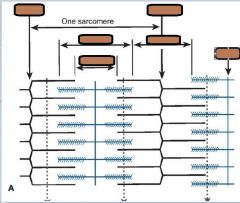
|

|
|
|
What does Troponin T, Troponin C & Troponin I do?
Where are they positioned? What makes up the Myosin molecule? |
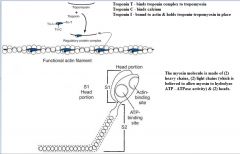
|
|
|
The I band consists of?
The A band consists of? The H band (zone) consists of? |
I band - Thin actin filaments
A band - Thin actin & thick myosin filaments H band (zone) - Thick myosin filaments |
|
|
Which way does the mysoin band contract? (toward what line on the sarcomere)
|
M line
|
|
|
Explain the (7) steps of the muscle cross-bridge cycle?
|
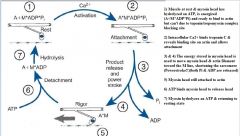
|
|
|
What ultimately regulates muscle contraction?
|
Ca2+ - Without Ca2+ troponin can not be moved from the binding site and contraction will not occur
|
|
|
What ultimately causes rigor mortis?
|
The loss of ATP causes the myosin heads to remain attached to the actin filaments and muscles locked in contraction
|
|
|
Describe the steps of excitation-contraction coupling in skeletal muscle?
|
1) Action potential depolarizes motor end plate, opening voltage-dependent Ca2+ channels
2) Ca2+ enters down concentration gradient causing ACh vesicles to be released into synapse 3) ACh binds nicotinic receptors on muscle membrane causing opening of ion channels and thus Na+ into muscle cell 4) Na+ depolarizes muscle membrane passing down into T-tubules where voltage-dependent Ca2+ channels are opened 5) These Ca2+ channels are physically attached to Ryanodine-Receptor (Ry-R) Ca2+ release channels on the sarcoplasmic reticulum 6) The Ry-R release channels activation causes Ca2+ to rush out of SR down its concentration gradient into the muscle 7) Calcium binds to troponin C & begins the crossbridge cycle |
|
|
How does the muscle relax after excitation-contraction coupling in skeletal muscle?
How do we increase the amount of Ca2+ stored in the SR? What ultimately causes muscle relaxation? |
Ca2+ is quickly taken up by sarcoplasmic reticular Ca2+ -ATPase (SERCA) that pumps Ca2+ back into SR against its concentration gradient using ATP
The amount of Ca2+ that can be stored by SR is increased by binding of Ca2+ to calsequestrin SERCA pumping Ca2+ back into SR & decreasing the amount of Ca2+ in myoplasm ultimately relaxes the muscle |
|
|
What type of contraction will a skeletal muscle action potential lead to?
|
Twitch contraction which can be either isometric or isotonic
|
|
|
What is an isotonic and isometric contraction?
|
isometric contraction - muscle develops force but doesn't shorten
isotonic contraction - muscle develops force and shortens |
|
|
What is preload?
What is afterload? |
Preload:
- resting, passive force on a muscle - determined by length of muscle (↑length = ↑preload) - can not be changed in a skeletal muscle b/c it is attached at both ends and thus preload is set for each muscle Afterload: - force the muscle must generate above preload to shorten |
|
|
What is an Isotonic contraction?
|
Isotonic contraction:
- muscle shortens while lifting a load - muscle generates force (preload) until it equals that generated by load and lift is established (afterload) & shortening takes place |
|
|
How will force be affected by a muscle increasing in length?
|
Force will increase w/ length b/c of the number of mysoin heads overlapping Actin binding sites
|
|
|
If we change the preload of a muscle, we can also expect overlap of actin & myosin to...?
|
Actin and Myosin crossbridges will have greater overlap until a specific point (optimum length) which the overlap of myosin heads with actin will begin to decrease
|
|
|
Can we change the preload in skeletal muscle within our bodies?
|
NO..preload is directly correlated w/ length and the length of our skeletal muscles are predetermined and can not be changed...cardiac muscle can increase preload
|
|
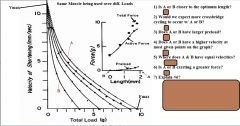
|

|
|
|
How does a muscle twitch (fasciculation) differ from tetanus?
|
A muscle twitch is a small, local, involuntary contraction and relaxation arising from the spontaneous discharge of a bundle of muscle fibers.
Tetanus in physiology refers to a fused, coordinated muscle contraction resulting from continuous and combined action potentials which stimulate the muscle |
|
|
What is temporal sumation?
What are (2) causes of temporal sumation? |
Temporal summation is the increasing frequency of stimulation which increases the force produced by each muscle fiber and thus increasing overall muscle force
1) First stimulation stretches the elastic component (connective tissue slack) while the second stimulus can simply be added to the isotonic contraction and not towards the elastic component 2) Ca2+ may still be in the cytosol from the first stimulation and when the second stimulation comes along there is extra Ca2+ available for increased contraction |
|
|
What is a motor unit?
What is the order of recruitment of motor units during skeletal muscle contraction of varying strengths? |
A motor unit is all the muscle fibers and branches associated w/ one motorneuron
The motor unit recruitment begins w/ small motor units and then activates larger motor units when increased strengths are needed. |
|
|
What are the (4) sources of ATP for muscle contraction?
Rank them in order from most quickly available to slowest availability? |
1) ATP storage - immediately avail.
2) Phosphorylcreatine (PCr + ADP) - avail. within seconds 3) Glucose/Glycogen (Glycolysis) - conversion into ATP is slower 4) Fats/Lipids (Krebs & oxidative phosphorylation) - conversion into ATP is very slow |
|
|
What are (5) differences between smooth and skeletal muscle machinery? (contractile filaments, cell bundles, SR, crossbridge recycling & energy, regulation)
|
Smooth muscle:
1) Contractile filaments arranged irregularly (no sarcomeres) - allows force over wide range of muscle lengths 2) Cell bundles have diverse orientations b/c of lacking discrete muscle origin & insertion 3) SR is not organized into T-tubule system 4) Crossbridge recycling & energy consumption is lower 5) Regulation is via myosin activation & NOT via troponins |
|
|
Explain smooth muscle contraction?
|

|
|
|
How does smooth muscle relax?
|
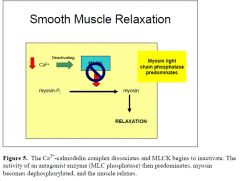
Decrease in Ca2+ levels causes Ca2+ - calmodulin complex to dissociate and MLCK inactivates. MLC phosphatase, antagonist enzyme, dephosphorylates myosin and muscle relaxes
|
|
|
What are the (3) ways Ca2+ can enter smooth muscle cells?
What are the (2) ways Ca2+ stores can be released from the SR? |
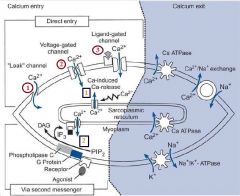
1) "Leak" channels
2) Voltage-gated channels 3) Ligan-gated channels SR release: 1) Ca-induced Ca-release 2) Second messanger & IP3 |
|
|
What are the (2) ways Ca2+ is taken out of smooth muscle cells?
What is (1) way Ca2+ is replenished in the SR? |
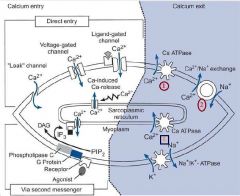
Membrane:
1) Ca2+ ATPase 2) Ca2+/Na+ exchange SR: 1) Ca2+ ATPase |
|
|
What are the (2) distinguishing differences between unitary and multiunit smooth muscle? (gap junctions, innervation)
|
1) Gap junctions
- Unitary has gap junctions joining ea. cell electrically together leading to coordinated contraction - Multiunit coordination is under neural control w/OUT gap junctions 2) Innervation - Unitary doesn't always require nervous stimulation for contraction and its gap junctions produce coordinated contractions (gut, uterus, some blood vessels) - Multiunit is innervated by atleast one neuron which allows for fine control of action (iris, some blood vessels) |
|
|
What are the (2) mechanisms underlying relaxation of smooth muscle induced by activation of cAMP or cGMP?
|
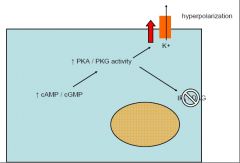
Activation of either cAMP or cGMP increases the activity of protein kinases which:
1) increase K+ channel activity & hyperpolarizing the membrane & decreasing the prbability of opening Ca2+ voltage-gated channels 2) they decrease the formation of IP3 & DAG which decreases release of Ca2+ from SR |

